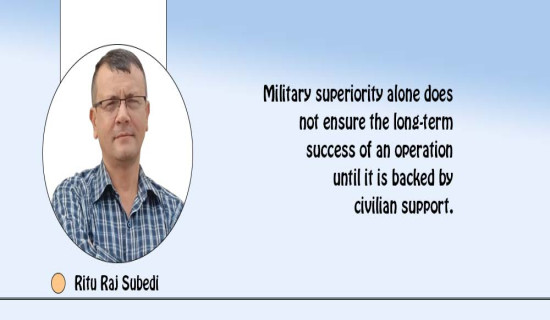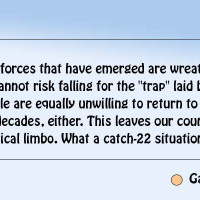- Monday, 12 January 2026
Nepal Should Exploit Geopolitical Dividend
Prime Minister Pushpa Kamal Dahal ‘Prachanda’ is the most astute politician of contemporary Nepal. Since 2005 Nepali politics has revolved around Prachanda and his agendas. He led a decade-long armed insurgency, which got partial success. A Comprehensive Peace Agreement was reached between the government of Nepal and CPN-Maoist in 2005 bringing the insurgents into peaceful and competitive politics as well as transforming Nepal from a monarchical unitary state to a federal democratic republic. A new constitution was written by a democratically elected Constituent Assembly that formally institutionalised the newly agreed political agendas. Maoists call it the outcome of the ‘people’s war’, while other parties contradict and claim that the epochal political change owes to the third Janaandolan (people’s movement).
Whatever the claims and counter-claims, the political change of 2005 is definitely a historic that has heralded a new era in Nepal’s political history. The role of the Maoist party and its supremo Prachanda was definitely important to bring about this phenomenal political change but equally important was the contribution of the seven parties. Since then Prachanda has continued to remain a pivotal figure in the Nepali politics, despite the fact that his party’s strength is steadily declining. Prachanda’s notable character is to take risk and make positional shifts in politics depending upon time and context. Loyalists call it Prachanda’s dynamism while critics censure him as being instable and unreliable. In the international front as well, Prachanda’s moves are worth watching as nobody knows what course of action he may take.
New world order
Against this background, Prime Minister Prachanda is in China on official visit. With Prahanda assuming office of prime minister third time last December this year, foreign policy watchers are closely monitoring his moves and manners in handling our foreign policy and diplomacy particularly with India, China and the United States. The world so far is unipolar dominated by the United States. But the unipolar world order is crumbling with China rising economically, militarily and technologically. It cannot be said with certainty what would be the next world order. But one thing is sure that the present unipolar world order will no longer be the case in the 21st century.
Countries have their own calculations, assumptions and expectations. Washington is effortful in maintaining the present unipolar world order intact for which it seeks to contain and weaken China. The United States has, accordingly, reached out to different countries in Asia and the Pacific region to build and strengthen alliances and partnership of varied natures under the broad Indo-Pacific Strategy. China’s inherent desire for a bipolar world can be understood from its strategic outreach projects in the name of different initiatives — Belt and Road Initiative (BRI), Global Development Initiative (GDI), Global Civilisation Initiative (GCI) and Global Security Initiative (GSI). These initiatives are interpreted as being directed to countering the US strategic design and enlarging its influence in the world. India has its own interest and calculation. India likes to see a multi-polar world order wherein New Delhi can be one of the multiple poles in the global affairs and play its role accordingly.
Since the international power shifts to Asia, the geopolitical competition is in Asia more particularly in South Asia, East Asia and South East Asia. Nepal is one of the pivotal areas of this geopolitical competition rivalry. Nepal’s geopolitical significance has amplified due to its location between the two key rival — India and China. Since Nepal is surrounded by India from three sides, India’s concerns and interests in Nepal are multiple - strategic, political, economic, social and cultural. Nepal and India have open and unregulated border and as well as free movement of people across the border, which sometimes creates irritants between the two countries. India tries to define Nepal as its sphere of influence and its backyard seeking to limit the presence of other countries.
Similarly, China’s, too, has its core concerns. China seeks credible assurance from Nepal on some key issues including continuity in One-China policy, control of anti-China activities and stable relations with it. In addition, China, recently appears a little more apprehensive of the presence of some external powers in Nepal, of which Beijing’s officials have occasionally been vocal. The United States, the lone super power, has its footprints in Nepal right from the latter half of the 20th century and it has recently intensified. Washington’s primary concerns and interests in Nepal are strategic and geopolitical. As United States designates China as a ‘serious threat’ to its global hegemony, America’s goal is to contain China from all possible frontiers of which Nepal could be one. Thus, United States wants its stronger and effective presence in Nepal.
Geopolitical location
In South Asia, India wants US to align its policy with that of New Delhi, but America, as a super power, has its independent policy and strategic choice, which is different from that of India. This makes triangular rivalry in South Asia more acute and Nepal is faced with this geopolitical reality. Tim Marshal says ‘countries are prisoners of geography’. He further says that geography can also be power of a country. Geography, therefore, is both boon and bane. Geography often dictates foreign policy. Given our geographical location and nature and behaviour of our two neighbours, Nepal has adopted non-aligned foreign policy and strictly stuck to it right from the time Nepal emerged as a nation-state. Given the present geopolitical scenario, Nepal’s location can be a boon provided we can astutely utilise this and extract geopolitical dividend.
Prime Minister Prachanda must have been aware of this geopolitical reality. We have no luxury to tilt to any of the international or regional powers at the expense of others. Details of achievements and agreements of Prachanda’s China visit have not yet been available, he has hit the nail on the head during his meetings and interactions with Chinese leaders and others. He also raised several pertinent issues in the United Nations. But homework and preparations were still felt inadequate. Some more important and pressing issues were not addressed in both the visits. Perhaps, such lapses will not recur in future.
(The author is former ambassador and former chief editor of this daily. lamsalyubanath@gmail.com)










-(1)-original-thumb.jpg)






